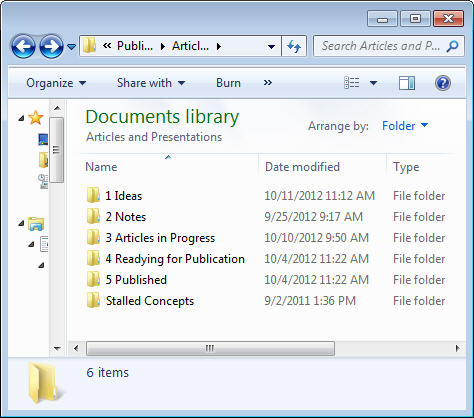My writing process consists of the following steps:
- generating ideas
- evaluating your ideas
- writing notes on a topic
- organizing your notes
- writing a first draft
- reviewing and revising your work
Generating Ideas
Where do ideas come from? I find that they come to me in two ways: some ideas spontaneously occur to me because of my life experiences, and I actively brainstorm to generate other ideas.
Noting Your Spontaneous Ideas
Anything in your daily work or personal life can prompt spontaneous ideas. They might come from a problem that occurs on a project, an interesting quotation, or even a unique person that you meet. For example, I got the idea for my column “Capturing User Research” when a client wouldn’t allow me to record audio during some very complex contextual inquiries. The inspiration for my column “Client Reactions to User Research Findings” came from a client who said, after a presentation, “If I gave this to our management, it would be like setting off a bomb in the room.” And watching the TV series Ghost Hunters got me to start thinking about the surprising parallels between ghost hunting and user research, which led to my column, “The Ghost Hunter’s Guide to User Research.”
So, always be ready to write down your spontaneous ideas as they occur to you, then transfer them to a master idea list like the one shown in Figure 1. At this point, you shouldn’t be concerned about whether they’re good ideas or would be the topic of an entire article. You should just list the ideas as they occur to you, then edit them later on.
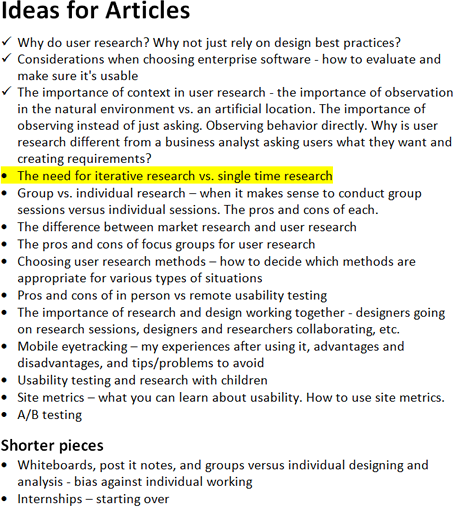
Brainstorming Ideas
Supplement your list of spontaneous ideas by occasionally sitting down to brainstorm on article ideas. If you get stuck for ideas, it might help if you start by listing topics that you know really well, subjects that you want to learn more about, and things that you’d like to read about.
Evaluating Your Ideas
Periodically evaluate the ideas in your master idea list to determine which ones look promising. You might find that some ideas would be good topics for a complete article, while others might make up parts of a larger article. Some may be really bad ideas, while others may spark other ideas. Make revisions and refinements to your ideas as necessary, group related ideas, and add any additional details that come to mind when reviewing your list.
Prioritize Your Ideas
Next, group your ideas by priority. Put your best ideas together in a group of the most promising topics that you’d like to work on first, followed by the so-so ideas, and finally, those you think are bad ideas, as shown in Figure 2. Why not just delete the bad ideas? It’s helpful to keep track of even what seem like bad ideas because sometimes they relate to what might become higher priority topics, spark another idea, or become part of a larger topic.
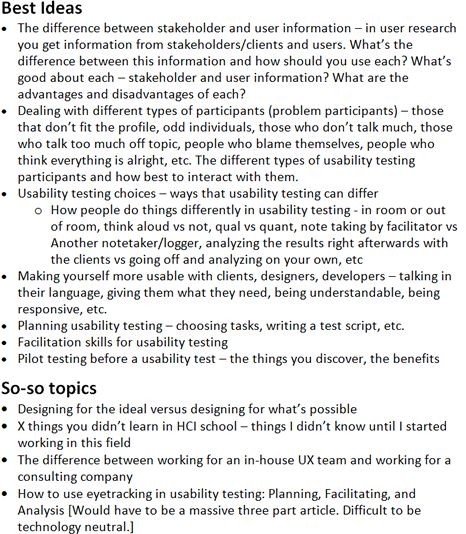
Writing Notes on a Topic
Pick one of the most promising ideas on your list and start brainstorming notes on that topic—writing whatever comes to mind. Capture your thoughts as bullet points without being concerned about the formalities of writing, as shown in Figure 3.
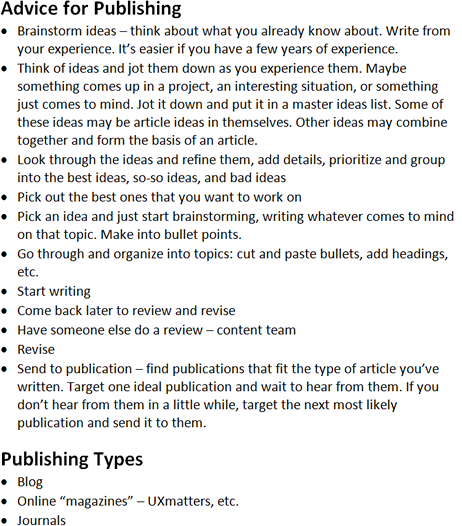
When it seems you’re running out of things to write about a topic, think about what additional subtopics you should include. For example, when making notes for my recent article about prototyping, once I’d exhausted the ideas that immediately occurred to me, I started listing subtopics such as the “advantages and disadvantages of low-fidelity prototypes” and “advantages and disadvantages of high-fidelity prototypes.” Once you’ve listed additional subtopics, write as much as you can about each of them. Finally, once you’ve exhausted a topic, put it aside, then come back to it at a later date. By that time, you may have thought of additional points to add.
Organizing Your Notes
Once you think you’ve written enough on a topic, it’s time to organize your notes. Cut and paste your bullet points into groups of related items, bringing them together into topics and subtopics, as shown in Figure 4. Add headings for each of your groupings, and determine their logical order in your article.
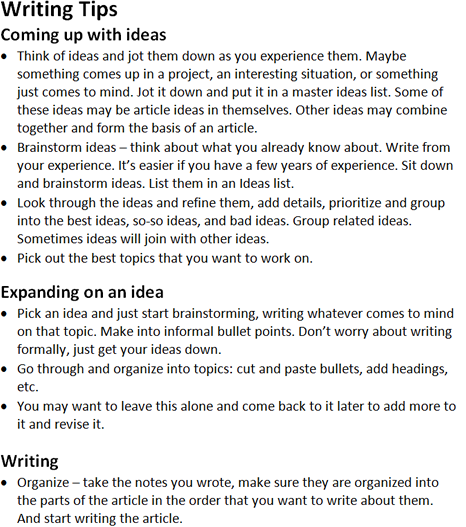
Writing a First Draft
Now, it’s time to write your first draft. Because you’ve already created a well-organized document with topics and supporting bullet points, it’s much easier to start writing. Since it’s a first draft, don’t worry too much about writing it perfectly. Figure 5 shows how I transform the bullet points into the headings and paragraphs that make up my article.
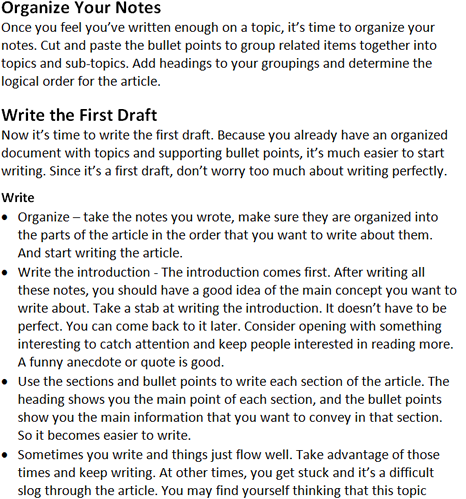
Getting in the Zone
Sometimes, when you write, you get into a perfect zone, where the words just seem to flow naturally onto the page. Take advantage of those times and keep writing as long as you can.
Dealing with Writer’s Block
At other times, writing anything may feel like a difficult slog. During these dark times, you may start to doubt that you’ve chosen the right topic or even your own ability to write. At that point, it’s best to just set your writing aside and do something else. Taking even a short break can do wonders, giving your relaxed mind a chance to solve whatever problem had you stymied. Usually, when you come back to your writing later, you’ll find that writing comes much easier.
Writing Your Introduction
Because it’s the first part of your article, you might consider writing your introduction first, but it’s often the most difficult part to write. It needs to introduce your topic, catch people’s attention, and keep them interested in reading further. Using a humorous anecdote, a quotation, or an example is often a good way to attract attention and draw in readers. If you have too much trouble writing the introduction, leave it for later, then come back to it after writing the rest of your article when it will be easier to summarize what your article is about.
Writing the Conclusion
Like the introduction, the conclusion can also be difficult to write. Since it’s usually the last thing you write, by the time you get that far, you may be tired of thinking about your topic. You may feel that you’ve already said all there is to say. But the purpose of a conclusion is to wrap up your article, state the broader implications of your topic, and point the way forward.
Some possibilities for conclusions are to restate your main theme, summarize your main points in a bulleted list, provide a key takeaway that your readers should remember, or offer an idea that ties in to an anecdote you used in your introduction.
Reviewing and Revising Your Work
After writing your first draft, it’s best to put it away for a while. You’re too close to the content to review it right away. If you come back to it after a few days, you can usually judge your writing with a more critical eye and make the necessary improvements. You may want to go through this process several times, setting your revised article aside, then coming back to it later and reviewing and revising it again.
Getting a Second Opinion
Once you’ve completed your revisions, it’s helpful to have someone else review your article. An editor or content professional can evaluate the effectiveness of your writing. A good content review involves much more than just checking for typos. A reviewer should evaluate your article for its logical organization, the smooth flow of information, the strength of your message, and correct style, grammar, and sentence structure. In addition to a content review, it’s also helpful to get a review from a member of your article’s audience—such as a fellow UX professional—who can evaluate the relevance and value of the content.
Once you’ve revised your article based on these reviews, you’re ready to get it published.
